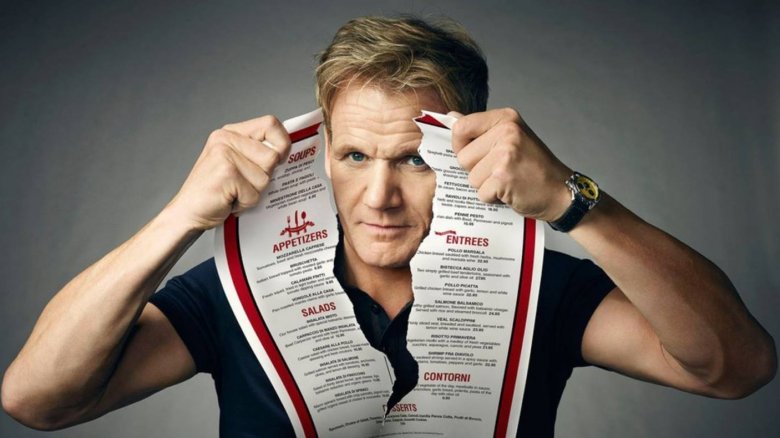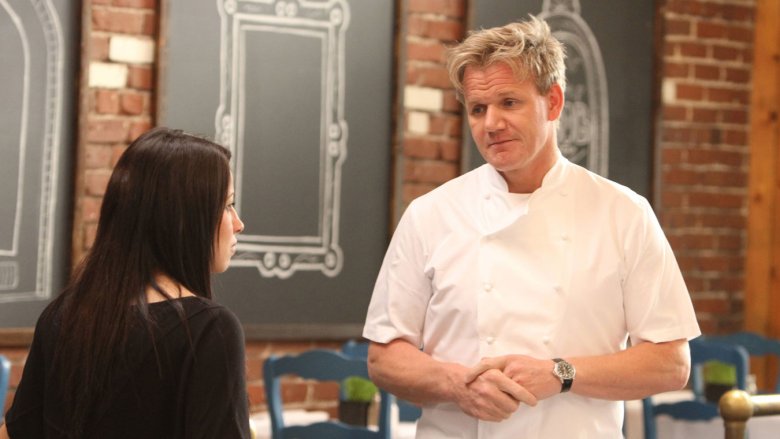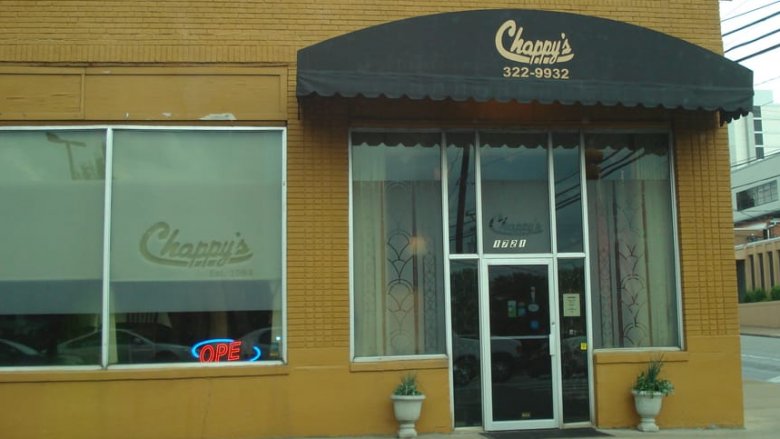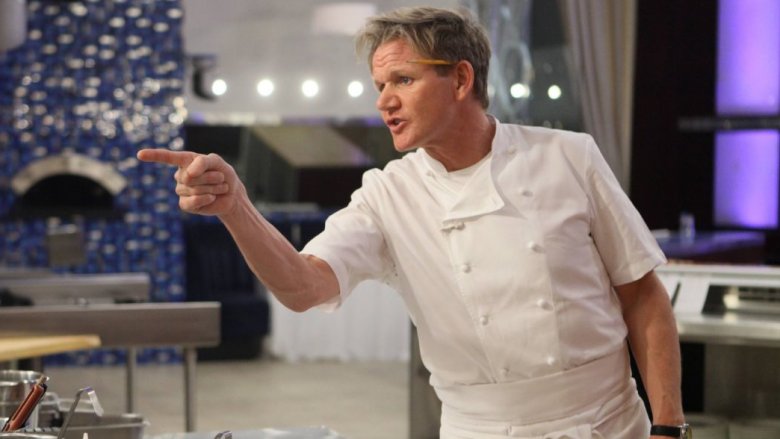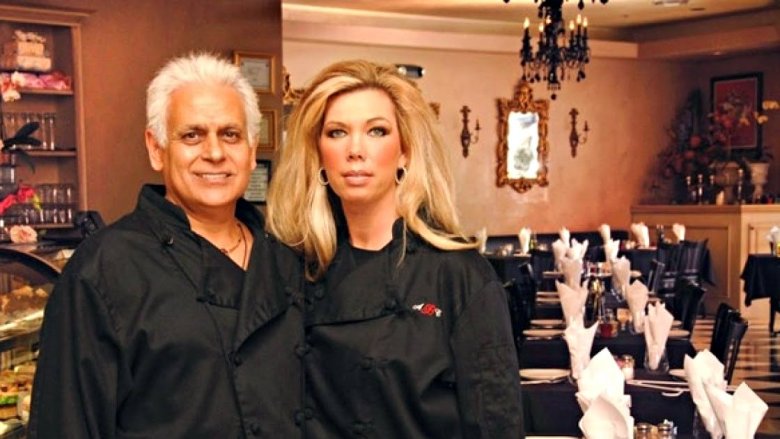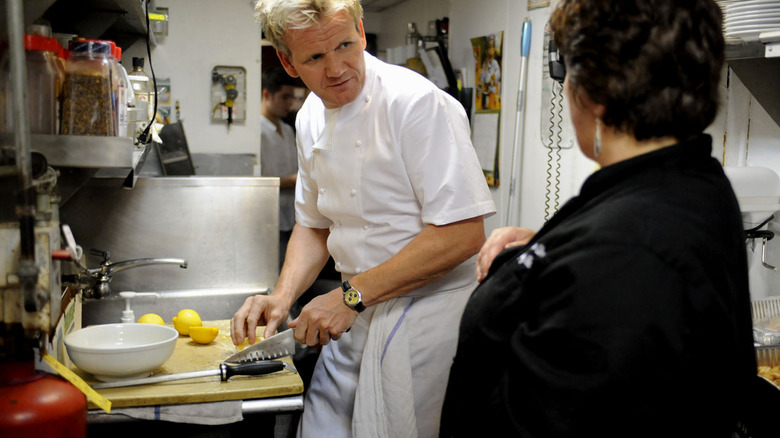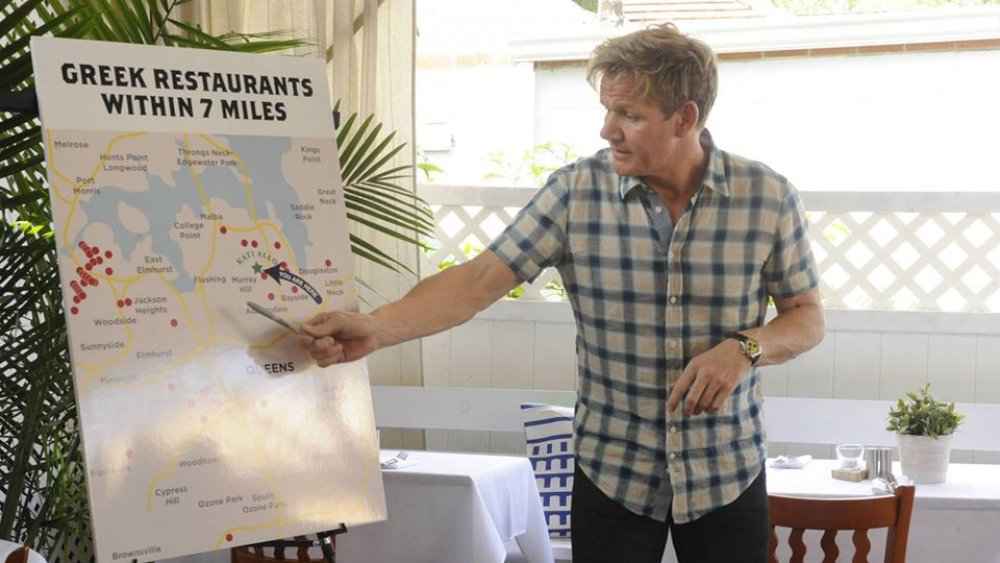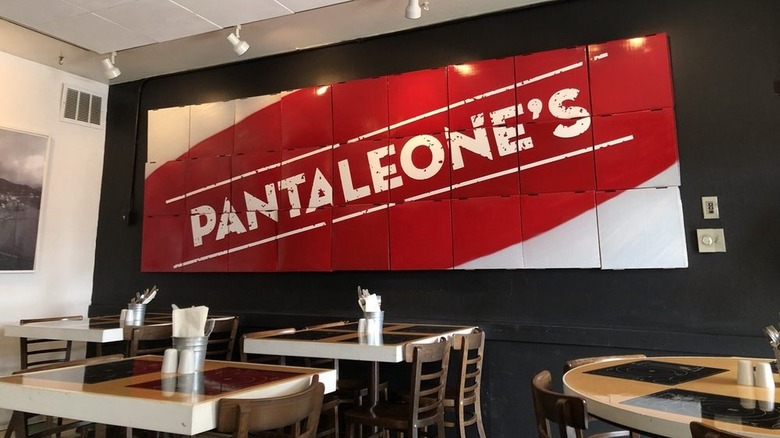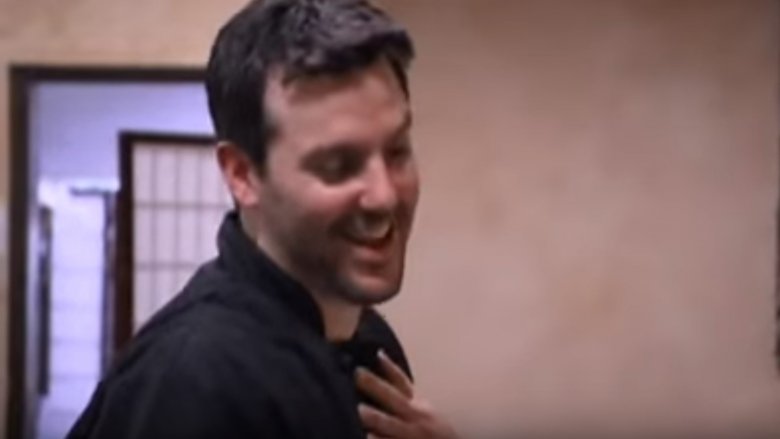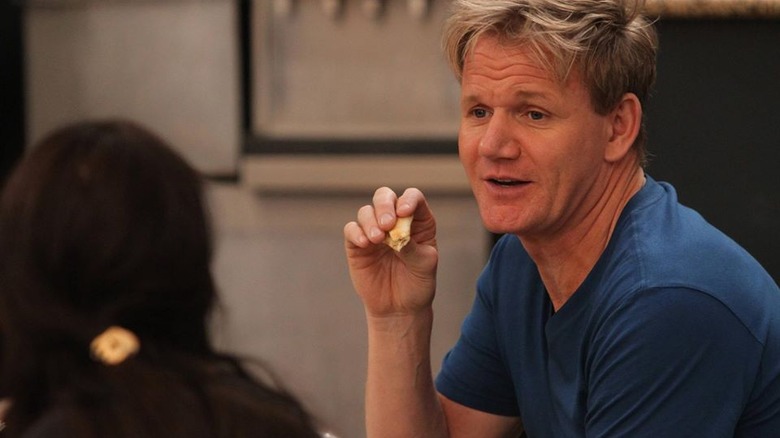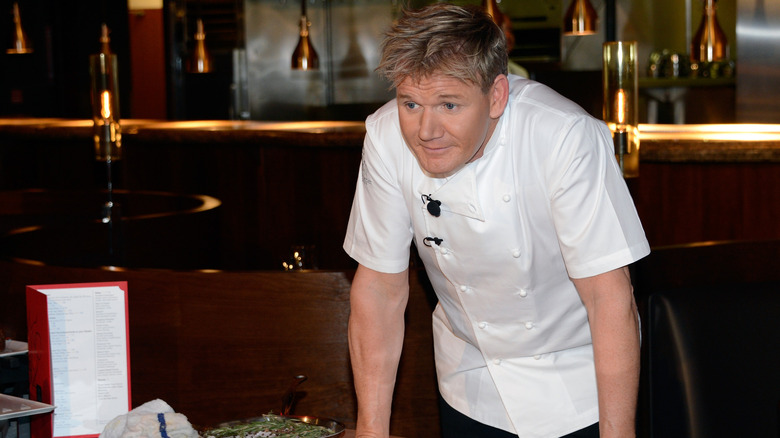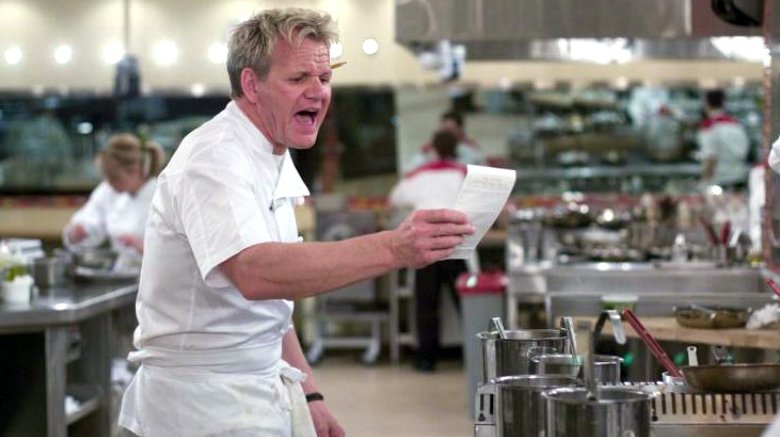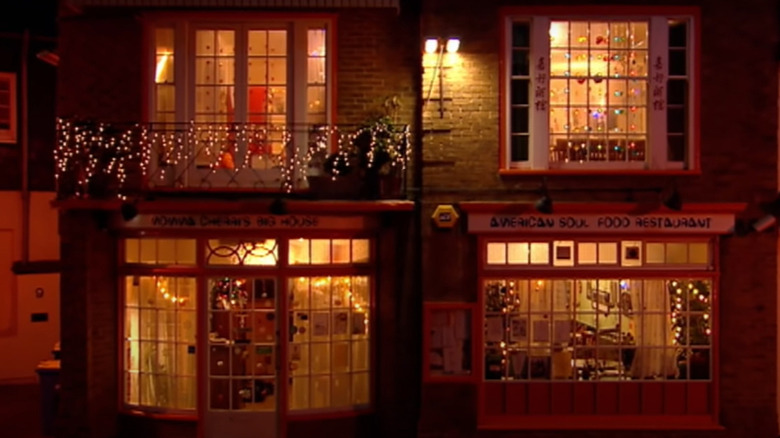Kitchen Nightmares: Secrets About The Gordon Ramsay Show
There's nothing quite like turning on a cooking show and hearing the dulcet sounds of Gordon Ramsay screaming at a befuddled chef. One of Ramsay's most popular profanity-riddled shows was "Kitchen Nightmares," where the hot-tempered Scottish chef and TV personality helped struggling and failing restaurants, mainly by shouting at them about fresh produce and frozen appetizers, while the owners crossed their arms stubbornly. By the end of the episode, the restaurant's inedible food and sub-par service were (usually) transformed and saved from extinction by crippling debt or sub-par Yelp reviews.
Despite the restaurant makeover show's long run (it ran from 2007 to 2014 and was then resurrected in 2023), there are still plenty of behind-the-scenes secrets that you probably never knew about "Kitchen Nightmares." From how the reality show was filmed (and how much of it was actually reality) to how well restaurants fared after Ramsay's team took over their kitchen, this is the untold truth of FOX's "Kitchen Nightmares."
Most of the Kitchen Nightmares eateries are now closed
Although Gordon Ramsay spent many glorious seasons transforming restaurants from one-star duds to passable eateries, apparently his professional magic wore off quickly for many of the restaurants that appeared on the show. In 2014, shortly after "Kitchen Nightmares" was canceled, The Daily Mail reported that 60% of the restaurants that appeared on the show had closed. "You don't ask to take part in a show called 'Kitchen Nightmares' if your restaurant business is booming and therefore it is not surprising that many of the restaurants which Gordon has visited over the 10 years are now closed," a spokesperson for Ramsay told The Daily Mail at the time.
As of 2024, 18 of the 84 restaurants that appeared on the show (including those features in its revival) are still open, according to Reality TV Updates. That means that for 79% of these restaurants, the "nightmare" is now over.
One restaurant closed before the Kitchen Nightmares episode even aired
As we now know, most of the restaurants that appeared on "Kitchen Nightmares" didn't exactly go on to have successful runs. But some of the restaurants fared worse than others. According to The Daily Mail's report, some restaurants were closed mere months after filming. One restaurant — The Black Pearl in New York — closed just four days after their episode aired. But there is one featured restaurant that takes the cake as the unluckiest of them all: Lela's in Pomona, California. It closed before viewers even saw its episode.
Before the episode aired, one blogger noted that Lela's website and contact information had been taken offline. According to Screen Rant, the restaurant already faced struggles before Gordon Ramsay got in the door and was facing bankruptcy after only eight months in business. After the episode was over, a message flashed on viewers' screens saying: "The restaurant's debts were too much and it closed."
One restaurant owner said that Ramsay's Kitchen Nightmares makeover ruined his restaurant
Although many of the restaurants featured on the show were happy to receive Ramsay's help, one chef in particular didn't mince words when it came to criticizing the changes the chef and his team made when he appeared on "Kitchen Nightmares." In an interview with The National Enquirer, John Chapman — restaurateur and owner of Chappy's on Church, featured in Season 6 — said, "It was truly a kitchen nightmare for me. Gordon Ramsay destroyed my business!"
Chapman said that Ramsay "hated everything" and redid the entire menu, replacing more authentic Creole fare with cheeseburgers and fried chicken. "My customers hated it," he said, and told The National Enquirer that business went from about 200 customers a night to a mere table of patrons per evening. Chapman repeated his story to multiple news outlets, including Biz Journals and FOX News.
Chappy's on Church closed in June 2013 for nonpayment of taxes, a mere month after the episode aired.
Gordon Ramsay has been sued multiple times by participants on Kitchen Nightmares
John Chapman isn't the only restaurant owner who was unhappy with the outcome of the show. Gordon Ramsay has been sued multiple times for his sometimes-explosive temper by unhappy restaurant owners and chefs on the show.
In 2008, Ramsay was sued for £500,000 ($679,000 USD) for calling a restaurant manager "a lazy t*****." Martin Hyde was the restaurant manager at Dillons — a restaurant in New York City — and said that he was chewed out by Ramsay even though he had no responsibility for the kitchen and mostly looked after the bar and restaurant events. "Being ridiculed by Gordon Ramsay on TV has wrecked my life," Hyde told The Daily Mail. "My reputation is in tatters and nobody wants to employ me."
In 2014, another show participant sued Ramsay after he and the show's host had "an explosive row," according to The Mirror. Joe Naggy, who owned the Norwalk, Ohio restaurant, Mill Street Bistro, sued Ramsay and his crew for damages to the restaurant, including a gutted ceiling that was never fixed, and received £900 ($1,233) in compensation.
The famous Amy's Baking Company episode was not staged
Do you remember that episode of "Kitchen Nightmares" where the owners were wackier than usual? The Amy's Baking Company episode of "Kitchen Nightmares" is probably the most infamous in the show's history, and the conflict was so severe that the crew didn't even get to complete their transformation. The shenanigans didn't end when the credits rolled either: The owners of the now-closed eatery were notorious for threatening customers who left bad Yelp reviews and for posting long rants on social media.
Although Amy's Baking Company is now closed, apparently their antics were just as off-the-wall as they appear in the show. One Medium blogger who was there during the filming of the two-part episode said that the "epic blowouts" from owners Amy and Samy were "100% true to form and not doctored for TV." Although blogger Greg Taylor said that the food was "just ok," the owner's behavior when he threw a tantrum was "shocking."
Gordon Ramsay's temper only explodes when he is on camera
Ramsay may be infamous for his nightmarish behavior on his shows, including "Kitchen Nightmares" and "Hell's Kitchen," but apparently most of his on-air tantrums and profanity-laced rants are hammed up for the camera.
According to one show crew member who did an AMA (Ask Me Anything) on Reddit in 2013, you'll rarely see Ramsay get angry when the cameras are turned off, although he said that Ramsay's temper is real (even if it is edited later on):
"You never see him get mad off camera, but that's because he doesn't have a reason to," the former "Kitchen Nightmares" the crew member said. "The only time I saw him explode was during the dinner service when the kitchen staff was serving food that was a legitimate health risk [...] He only gets mad when he has a reason to, otherwise he's a very funny and nice dude. You can even see that in all of his U.K. shows. The U.S. versions like to selectively edit to play up drama."
Restaurant owners don't interact much with Gordon Ramsay
Even though you may think of the show "Kitchen Nightmares" as Gordon Ramsay's show, one couple who appeared on the show in Season 3, said in a 2010 interview with The New Jersey Record that they mostly interacted with Ramsay's team and crew, and barely conversed with the famous TV chef at all. "You have no interaction with Ramsay at all. He comes with a very big machine of assistants and helpers. The only time that I ever spent any time with him was on camera."
The couple also pointed out that the producers of "Kitchen Nightmares" would generally try to stir up drama by asking them pointed questions like, "If this fails now, how can you stay with your husband?"
They ended up being happy with the way that Ramsay's team "set their restaurant up for long-term success." However, their restaurant, Bazzini, in Ridgewood, New Jersey is now closed.
It's not the same Kitchen Nightmares the U.K. originally got
You're familiar with the "Kitchen Nightmares" formula, right? Ramsay comes into a failing restaurant, berates owners and staff alike, and bullies them into being better. There's a lot of swearing, a lot of name-calling, and the sort of abuse you sort of always wanted to see heaped on authority figures. Only, that's not what you get at all in the original U.K. version — and The AV Club took a look at the differences.
When they watched the original U.K. version, they found a totally different Ramsay. The swearing, the cursing, and the yelling was gone, for the most part. He worked with restaurant owners, instead of coming in like a bulldozer. The narration was Ramsay himself, and it was Ramsay that seemed to know many were trying their best, they just had no clue how to fix what had gone wrong. There was some yelling, sure, but nothing on the scale of the U.S. version. He's so different that you'll have to wonder if he's actually someone else wearing a Gordon Ramsay skin-suit, and it's a shame Americans don't get to see that side of him very often.
One restaurant owner from Kitchen Nightmares had mob ties
During the first season of "Kitchen Nightmares," in 2007, Ramsay and his team actually gave a helping hand to an ex-mobster. Peter's was a New York restaurant featured on an episode where the problem was the owner's extravagant spending. It only came out later, when Gang Land News (via Cosa Nostra News) uncovered an FBI report from 2003 that said Peter "Pasta" Pellegrino had been a recently made man associated with the Bonanno crime family.
According to the Cosa Nostra News, Peter Pasta had already been kicked out of the family by the time he was on "Kitchen Nightmares," as he had apparently been "falsely labeled 'a rat', with all its obvious nasty ramifications and ugly possibilities hanging over his head."
It may have been for the best that Pellegrino had already been ousted by the mob before he saw how his episode turned out, as he had nothing good to say about the way he was portrayed. "That makes me look like... some kind of an animal, and worse. It's a real-life nightmare," he told Gang Land News.
Customers on Kitchen Nightmares are paid
There have been a lot of accusations leveled at Ramsay and "Kitchen Nightmares," including claims that the show's team plants a lot of the rotten food he "finds" and that all of those incredibly grossed-out customers that sit down to eat are paid actors. According to The Guardian, Ramsay doesn't take the accusations lightly, and after one newspaper published stories about fakery, he sued for libel and won. But there's one claim that might have some weight to it, and that's the one where customers are said to be paid actors. It's likely a half-truth, if the fine print of the credits is to be believed.
Reality Blurred picked up on the disclaimers, written in the credits that most of us fast-forward through. One reads, "The producers may have provided customers at the restaurant with a financial contribution towards the cost of their meal."
What, exactly, that means isn't clear, and while it doesn't suggest they're actors, they are getting compensated for being on the show. But isn't that fair? You wouldn't want to pay for some of the food these places are serving up pre-Ramsay, would you?
One Kitchen Nightmares restaurant sued Ramsay twice
It's no secret that the restaurants on "Kitchen Nightmares" don't feature the kinds of kitchens you'd want your food coming out of ... not at first, at least. So, it's also not surprising that some have taken issue with the way they're portrayed — perhaps none more strongly than Oceana Grill. The New Orleans seafood joint has sued Ramsay not once, but twice.
According to Today, the first lawsuit came in 2011. The owners of Oceana didn't want the episode to air because they felt they had been misrepresented — and in case you're wondering just which episode this was, you know the infamous clip: Ramsay vomiting after getting a whiff of some supposedly rotten shrimp. The episode still made it to air, but there were concessions made in the form of a settlement where the show's producers agreed that if footage from Oceana was used in the future, the restaurant would be paid for it. They were also required to update viewers to the changes made at the restaurant any time they were featured.
The second lawsuit came in 2018, when the "Kitchen Nightmares" British Facebook page posted that infamous, aforementioned clip with the caption, "No wonder this restaurant is failing..." Oceana and their legal team took issue with the fact that the post made it look like the restaurant was still in the same state it was seven years prior (which they called "largely fabricated in the first place.") Lesson? Be careful what you post on Facebook.
Yes, there are some success stories from Kitchen Nightmares
Sure, "Kitchen Nightmares" is a little notorious for its failure rate, but there are some major success stories.
Like Pantaleone's, the Denver pizza place with an owner who just couldn't understand why no one was coming in the door. It was the typical "Kitchen Nightmares" mess: denial, stress, and struggle. Fast forward to after filming, and the Gazette Review said the pizza place went on to become a success. Sure, there's still some grumbling, but based on their TripAdvisor and Yelp reviews, they're consistently 4-5 stars.
Yanni's Greek Cuisine is still open, too, from Season 6. The hundreds of reviews on Yelp have them sitting at a comfortable 4 stars, while TripAdvisor has them at 4.5. Not all the restaurants "Kitchen Nightmares" have visited reverted back to their old ways and for some, the experience truly was life changing.
The suicide of one restaurant owner had an eerie connection to a Kitchen Nightmares episode
In 2007, "Kitchen Nightmares" visited Campania, an Italian restaurant in New Jersey where the problem was a boss that was too laid-back to tell employees what needed to be done to make them successful. When NJ.com ran a follow-up article with the headline "Joe Cerniglia of Campania survived Gordon Ramsay's Kitchen Nightmares", he didn't have anything bad to say about the experience. But they had no idea what kind of terrible foreshadowing the headline held.
In 2010, ABC News reported that chef Joe Cerniglia had died by suicide. It was only a day later that the New York Post (via Fox News) connected his personal problems to an affair he'd been having with a pastry chef at the restaurant (amid a separation from his wife), and only a day after that E! News found he'd had previous issues with cocaine and narcotics.
The tragedy happened a few years after "Kitchen Nightmares," but news outlets were quick to point out something eerie: Ramsay had told him, "Your business is about to f*****g swim down the Hudson" ... which was precisely where his body was discovered.
If you or someone you know is struggling or in crisis, help is available. Call or text 988 or chat 988lifeline.org
That time Gordon Ramsay tricked a vegetarian into eating ham
The decision to go vegetarian isn't for everyone, but it's simple enough to respect it. Ramsay got quite a bit of heat from the media after the airing of a U.K. episode of "Kitchen Nightmares" at La Lanterna in Hertfordshire (via The Telegraph), because of a cruel "prank" played on one vegetarian on the show.
The incident involved volunteers, including one eight-year vegetarian, recruited on the street to sample pizzas from the featured restaurant. When it was time to try the pizza, Ramsay assured a volunteer that one was, in fact, vegetarian. After the man ate it, he clarified ... it was vegetarian except for the ham. Ramsay laughed as the man ran off, and a slew of celebrity chefs condemned the disrespect (and many celebrity chefs had already criticized Ramsay for other transgressions).
The Guardian was quick to point out just how bad an example he was setting, asking if he would have played the same "joke" on someone who avoided certain foods for religious reasons or because of allergies.
Here's why Ramsay's failure rate for Kitchen Nightmares is really so high
For all the restaurants that do fail after a Gordon Ramsay-led makeover on Kitchen Nightmares, it seems a little mind-boggling from the viewer's point of view. But Gene Marks of the small business consulting firm The Marks Group said (via Entrepreneur) that there's something going on here that viewers don't see.
He said that running a successful restaurant is about more than just good food — it's the ability to think on the fly, to organize, to manage, to market, and make the tough business decisions that pop up on a daily basis. Some of that can be taught, but some can't. What it comes down to is that some people have the innate ability to run a successful business, and some don't — but everyone seems to think they've got what it takes to run a restaurant. According to Marks, it doesn't matter how good a menu is, if there's not that innate business acumen, it just isn't going to work.
He's got a different take on the numbers, too. In his 2015 article, Marks said: "... a whopping 60% of the restaurants Ramsay tried to help failed after his visit. Does this surprise you? [...] Based on my experiences, I would've thought that the number was higher. The fact that it's only a 60% failure rate is a testament to Ramsay's abilities."
Gordon Ramsay regretted ending Kitchen Nightmares
Are you a "Kitchen Nightmares" superfan who missed the show after its cancelation in 2014? Ramsay feels your pain. The popular show that launched Ramsay's TV career ended in part because Ramsay was tired of the restaurants he fixed reverting back to their old ways and failing, which may explain why so many of the restaurants closed since their episodes aired.
In an interview with The New York Daily News in 2017, Ramsay explained that he was tired of the criticism he was getting from fans for "Kitchen Nightmares" restaurants closing left and right. "I got fed up with 'Kitchen Nightmares' because I was getting s***," he said. "So I woke up one morning and I thought 'f*** it, I'm done.' "
He added his remorse at the decision to pull his own show off the air, which was admittedly made in anger: "Yes it was wrong to pull my own show off air, but that's it." Fortunately for all us fans, the show returned in 2023.
Kitchen Nightmares' biggest success was actually a failure
A lot has been said about the restaurants that reverted to their old ways after the cameras left and Ramsay moved on to verbally berate the next set of restaurateurs and their hapless employees. But not every restaurant that did what they were told became prosperous, and at least one may have become too prosperous.
Widely considered to be the biggest success story of "Kitchen Nightmares," after its 2004 appearance, Momma Cherri's in Brighton, England, went on to become wildly successful before promptly closing its doors in 2007. Momma Cherri's was famous for being that one restaurant with food that Ramsay did not actually hate — in fact, he cleaned his plate. So instead of giving the staff a cooking lesson, Chef Yells-A-Lot helped the owner make some other business tweaks — including educating the local Brits about the wonders of American soul food.
After the show aired, Momma Cherri's became so popular that it had to expand to make room for all of Brighton's new soul food connoisseurs. But when Ramsay revisited the restaurant in 2006, he found that the restaurant's chefs were pre-cooking the food to help cope with high demand, which meant poorer quality food and unhappy customers. By 2007, the restaurant was "put into administration" (that's British for "bankruptcy"), which means its failure was probably as much about not having the money to sustain its growth as it was about the pre-cooked food.
The last straw for Ramsay was an eatery in a ski resort
There's always a last straw, and though the demise of "Kitchen Nightmares" was partially driven by restaurant owners who reverted to their old ways, failed, and blamed Ramsay for not saving them, the last straw was something else entirely.
In a 2018 interview with Entertainment Weekly, Ramsay said he spent a week in the South of France trying to help an eatery in a ski resort. The person running the operation, Ramsay said, felt like he could take advantage of his captive audience of people with "nowhere else to eat."
Now, even people who don't have successful restaurant-rescue programs understand that restaurants need happy customers, not just present customers. After all, you can always bring some canned chili and a bag of shredded cheese to the ski resort rather than force yourself to eat overpriced, tasteless food served up by people who are far more interested in your money than your satisfaction. It's not like Ramsay had never dealt with similarly misguided restaurant owners or managers or chefs, but there's only so much a TV chef can take. The person's attitude, along with his typical "I-can't-hear-you-la-la-la" response to all of Ramsay's advice was the final death blow for "Kitchen Nightmares."
